window FORD THUNDERBIRD 2003 11.G User Guide
[x] Cancel search | Manufacturer: FORD, Model Year: 2003, Model line: THUNDERBIRD, Model: FORD THUNDERBIRD 2003 11.GPages: 200, PDF Size: 1.79 MB
Page 47 of 200
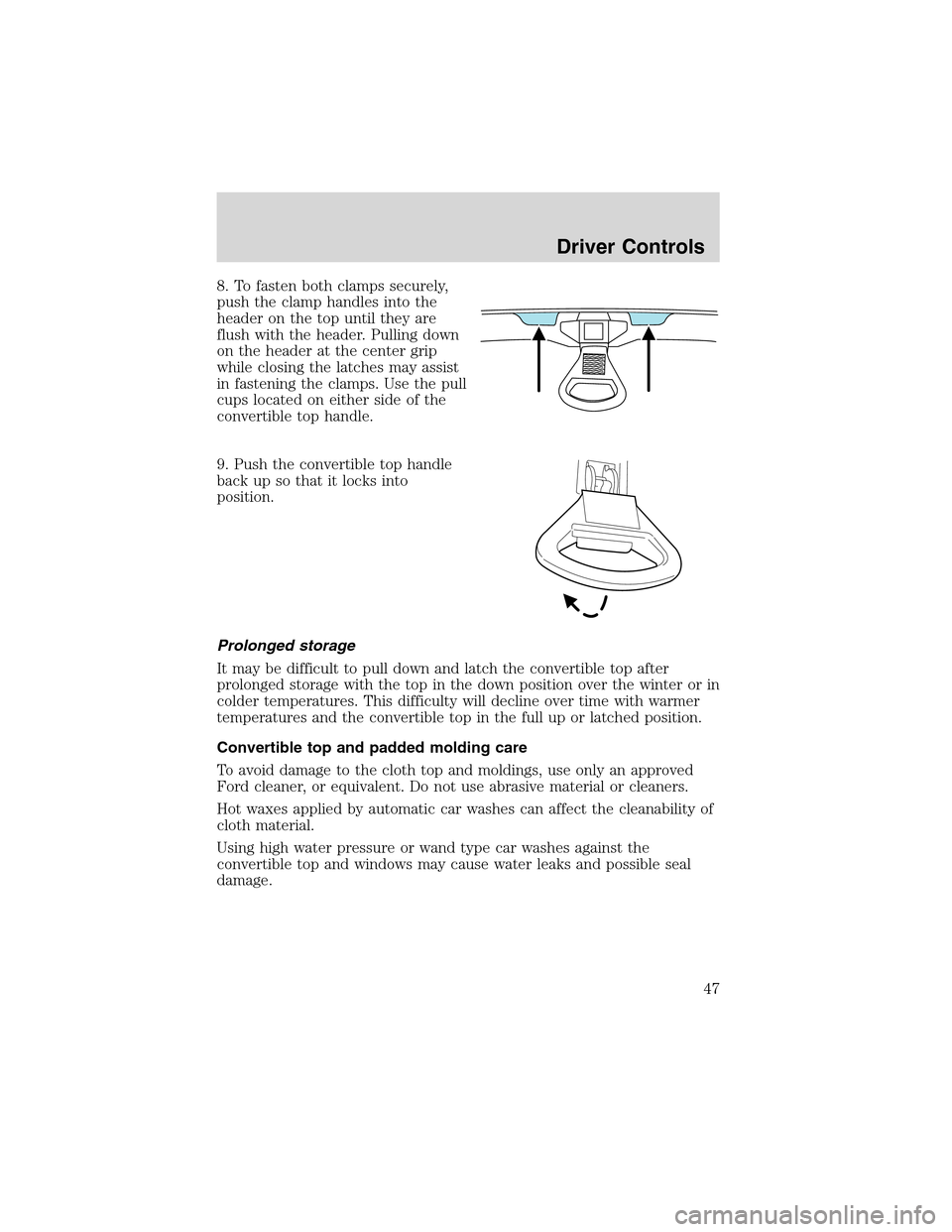
8. To fasten both clamps securely,
push the clamp handles into the
header on the top until they are
flush with the header. Pulling down
on the header at the center grip
while closing the latches may assist
in fastening the clamps. Use the pull
cups located on either side of the
convertible top handle.
9. Push the convertible top handle
back up so that it locks into
position.
Prolonged storage
It may be difficult to pull down and latch the convertible top after
prolonged storage with the top in the down position over the winter or in
colder temperatures. This difficulty will decline over time with warmer
temperatures and the convertible top in the full up or latched position.
Convertible top and padded molding care
To avoid damage to the cloth top and moldings, use only an approved
Ford cleaner, or equivalent. Do not use abrasive material or cleaners.
Hot waxes applied by automatic car washes can affect the cleanability of
cloth material.
Using high water pressure or wand type car washes against the
convertible top and windows may cause water leaks and possible seal
damage.
Driver Controls
47
Page 48 of 200
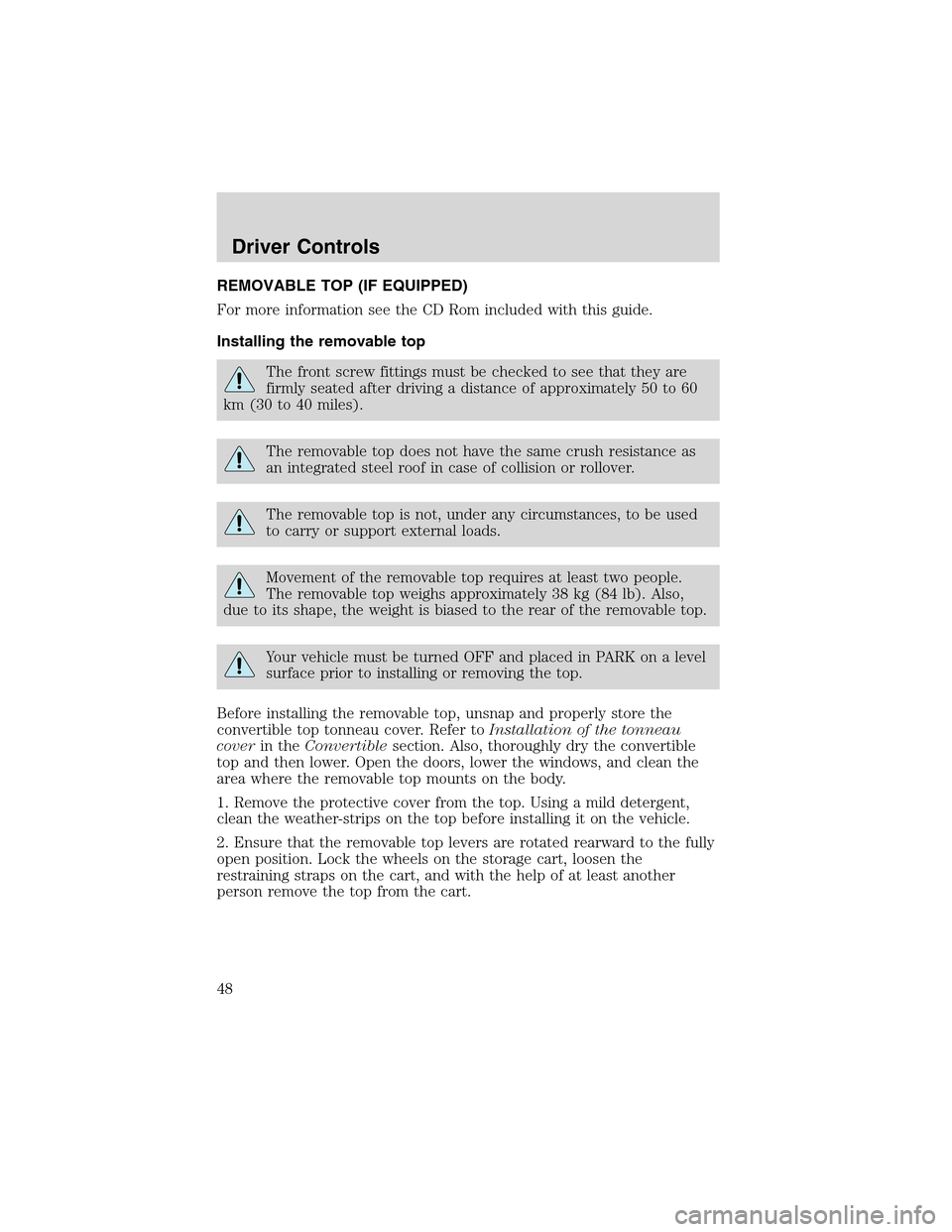
REMOVABLE TOP (IF EQUIPPED)
For more information see the CD Rom included with this guide.
Installing the removable top
The front screw fittings must be checked to see that they are
firmly seated after driving a distance of approximately 50 to 60
km (30 to 40 miles).
The removable top does not have the same crush resistance as
an integrated steel roof in case of collision or rollover.
The removable top is not, under any circumstances, to be used
to carry or support external loads.
Movement of the removable top requires at least two people.
The removable top weighs approximately 38 kg (84 lb). Also,
due to its shape, the weight is biased to the rear of the removable top.
Your vehicle must be turned OFF and placed in PARK on a level
surface prior to installing or removing the top.
Before installing the removable top, unsnap and properly store the
convertible top tonneau cover. Refer toInstallation of the tonneau
coverin theConvertiblesection. Also, thoroughly dry the convertible
top and then lower. Open the doors, lower the windows, and clean the
area where the removable top mounts on the body.
1. Remove the protective cover from the top. Using a mild detergent,
clean the weather-strips on the top before installing it on the vehicle.
2. Ensure that the removable top levers are rotated rearward to the fully
open position. Lock the wheels on the storage cart, loosen the
restraining straps on the cart, and with the help of at least another
person remove the top from the cart.
Driver Controls
48
Page 102 of 200
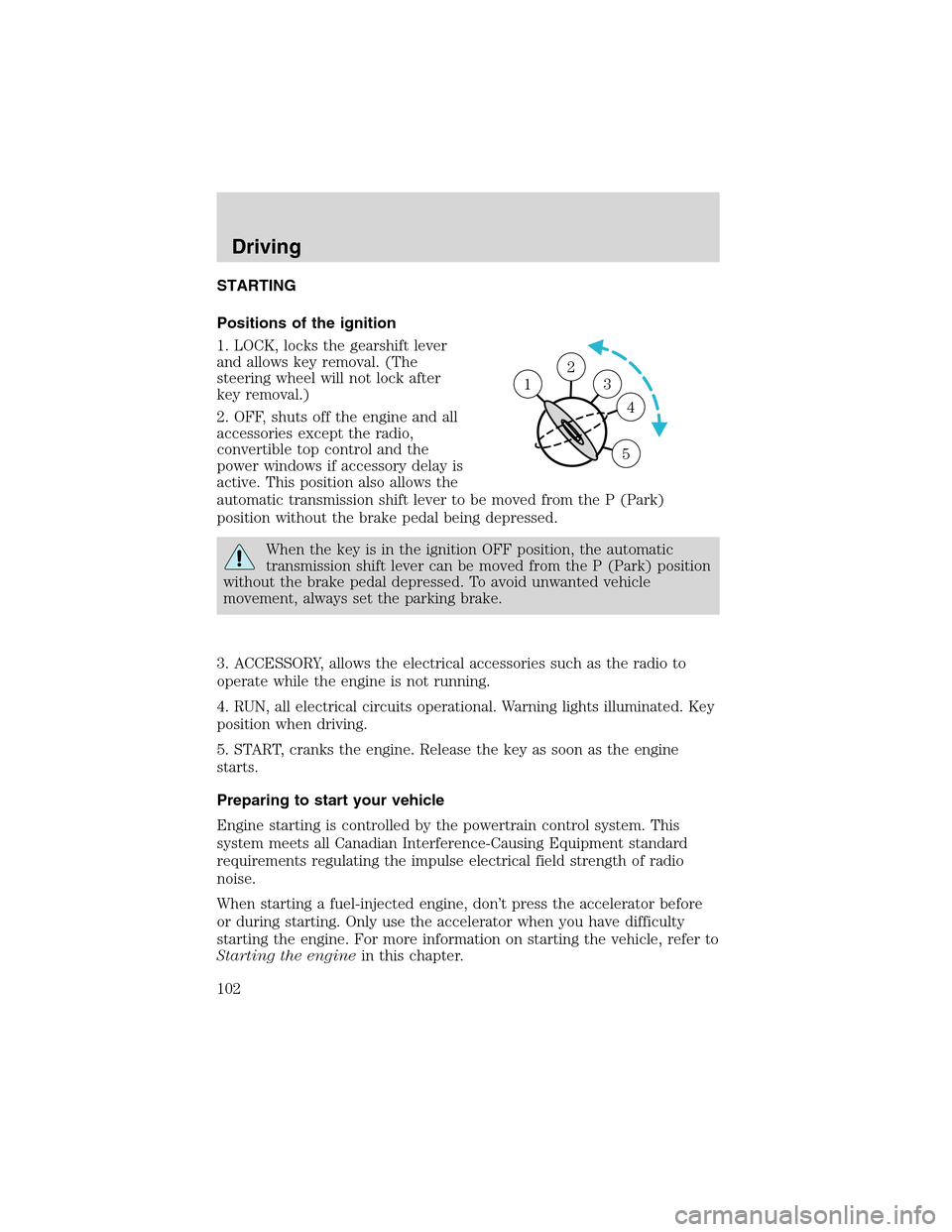
STARTING
Positions of the ignition
1. LOCK, locks the gearshift lever
and allows key removal. (The
steering wheel will not lock after
key removal.)
2. OFF, shuts off the engine and all
accessories except the radio,
convertible top control and the
power windows if accessory delay is
active. This position also allows the
automatic transmission shift lever to be moved from the P (Park)
position without the brake pedal being depressed.
When the key is in the ignition OFF position, the automatic
transmission shift lever can be moved from the P (Park) position
without the brake pedal depressed. To avoid unwanted vehicle
movement, always set the parking brake.
3. ACCESSORY, allows the electrical accessories such as the radio to
operate while the engine is not running.
4. RUN, all electrical circuits operational. Warning lights illuminated. Key
position when driving.
5. START, cranks the engine. Release the key as soon as the engine
starts.
Preparing to start your vehicle
Engine starting is controlled by the powertrain control system. This
system meets all Canadian Interference-Causing Equipment standard
requirements regulating the impulse electrical field strength of radio
noise.
When starting a fuel-injected engine, don’t press the accelerator before
or during starting. Only use the accelerator when you have difficulty
starting the engine. For more information on starting the vehicle, refer to
Starting the enginein this chapter.
2
3
4
5
1
Driving
102
Page 105 of 200
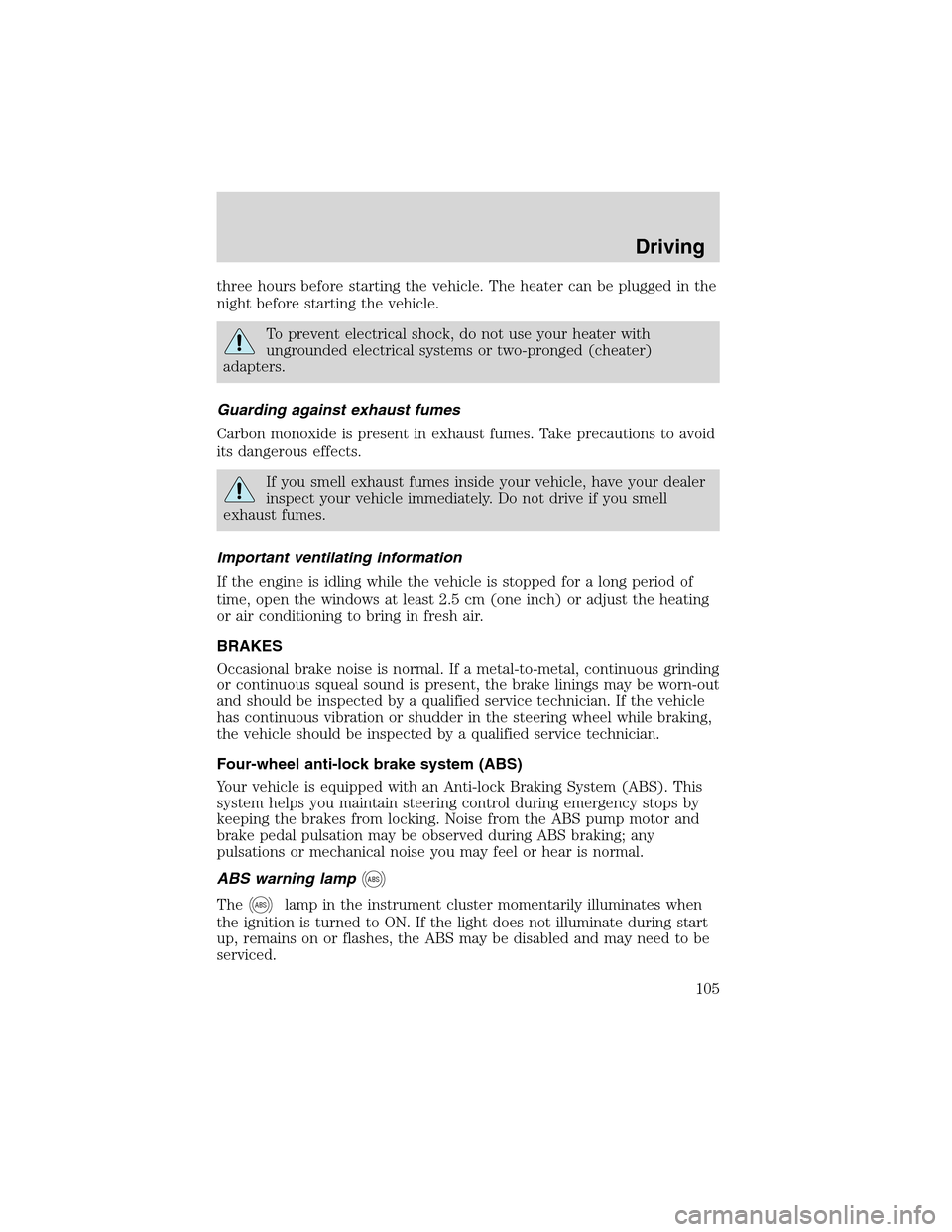
three hours before starting the vehicle. The heater can be plugged in the
night before starting the vehicle.
To prevent electrical shock, do not use your heater with
ungrounded electrical systems or two-pronged (cheater)
adapters.
Guarding against exhaust fumes
Carbon monoxide is present in exhaust fumes. Take precautions to avoid
its dangerous effects.
If you smell exhaust fumes inside your vehicle, have your dealer
inspect your vehicle immediately. Do not drive if you smell
exhaust fumes.
Important ventilating information
If the engine is idling while the vehicle is stopped for a long period of
time, open the windows at least 2.5 cm (one inch) or adjust the heating
or air conditioning to bring in fresh air.
BRAKES
Occasional brake noise is normal. If a metal-to-metal, continuous grinding
or continuous squeal sound is present, the brake linings may be worn-out
and should be inspected by a qualified service technician. If the vehicle
has continuous vibration or shudder in the steering wheel while braking,
the vehicle should be inspected by a qualified service technician.
Four-wheel anti-lock brake system (ABS)
Your vehicle is equipped with an Anti-lock Braking System (ABS). This
system helps you maintain steering control during emergency stops by
keeping the brakes from locking. Noise from the ABS pump motor and
brake pedal pulsation may be observed during ABS braking; any
pulsations or mechanical noise you may feel or hear is normal.
ABS warning lamp
ABS
TheABSlamp in the instrument cluster momentarily illuminates when
the ignition is turned to ON. If the light does not illuminate during start
up, remains on or flashes, the ABS may be disabled and may need to be
serviced.
Driving
105
Page 126 of 200
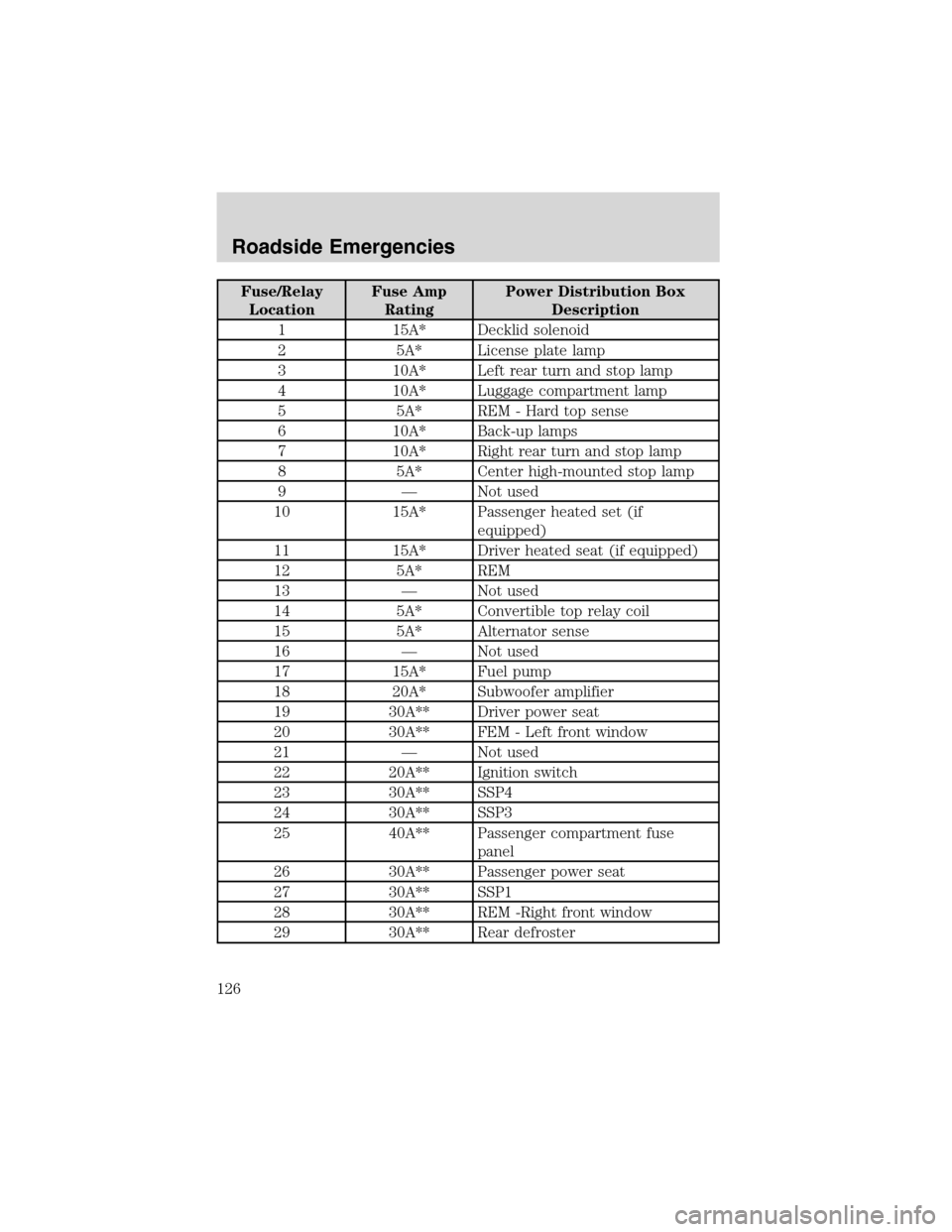
Fuse/Relay
LocationFuse Amp
RatingPower Distribution Box
Description
1 15A* Decklid solenoid
2 5A* License plate lamp
3 10A* Left rear turn and stop lamp
4 10A* Luggage compartment lamp
5 5A* REM - Hard top sense
6 10A* Back-up lamps
7 10A* Right rear turn and stop lamp
8 5A* Center high-mounted stop lamp
9—Not used
10 15A* Passenger heated set (if
equipped)
11 15A* Driver heated seat (if equipped)
12 5A* REM
13—Not used
14 5A* Convertible top relay coil
15 5A* Alternator sense
16—Not used
17 15A* Fuel pump
18 20A* Subwoofer amplifier
19 30A** Driver power seat
20 30A** FEM - Left front window
21—Not used
22 20A** Ignition switch
23 30A** SSP4
24 30A** SSP3
25 40A** Passenger compartment fuse
panel
26 30A** Passenger power seat
27 30A** SSP1
28 30A** REM -Right front window
29 30A** Rear defroster
Roadside Emergencies
126
Page 150 of 200
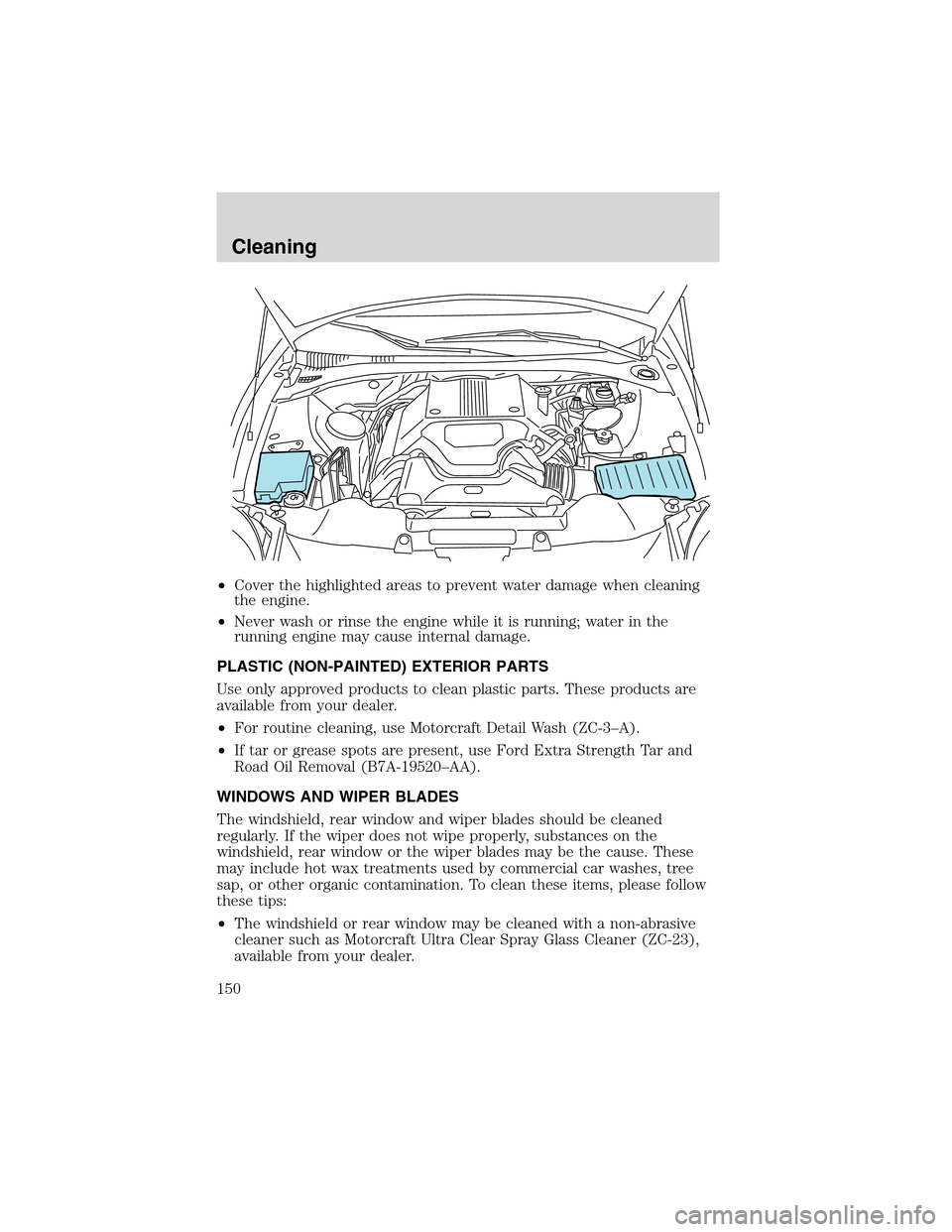
•Coverthehighlightedareas to prevent water damage when cleaning
the engine.
•Never wash or rinse the engine while it is running; water in the
running engine may cause internal damage.
PLASTIC (NON-PAINTED) EXTERIOR PARTS
Use only approved products to clean plastic parts. These products are
available from your dealer.
•For routine cleaning, use Motorcraft Detail Wash (ZC-3–A).
•If tar or grease spots are present, use Ford Extra Strength Tar and
Road Oil Removal (B7A-19520–AA).
WINDOWS AND WIPER BLADES
The windshield, rear window and wiper blades should be cleaned
regularly. If the wiper does not wipe properly, substances on the
windshield, rear window or the wiper blades may be the cause. These
may include hot wax treatments used by commercial car washes, tree
sap, or other organic contamination. To clean these items, please follow
these tips:
•The windshield or rear window may be cleaned with a non-abrasive
cleaner such as Motorcraft Ultra Clear Spray Glass Cleaner (ZC-23),
available from your dealer.
Cleaning
150
Page 151 of 200
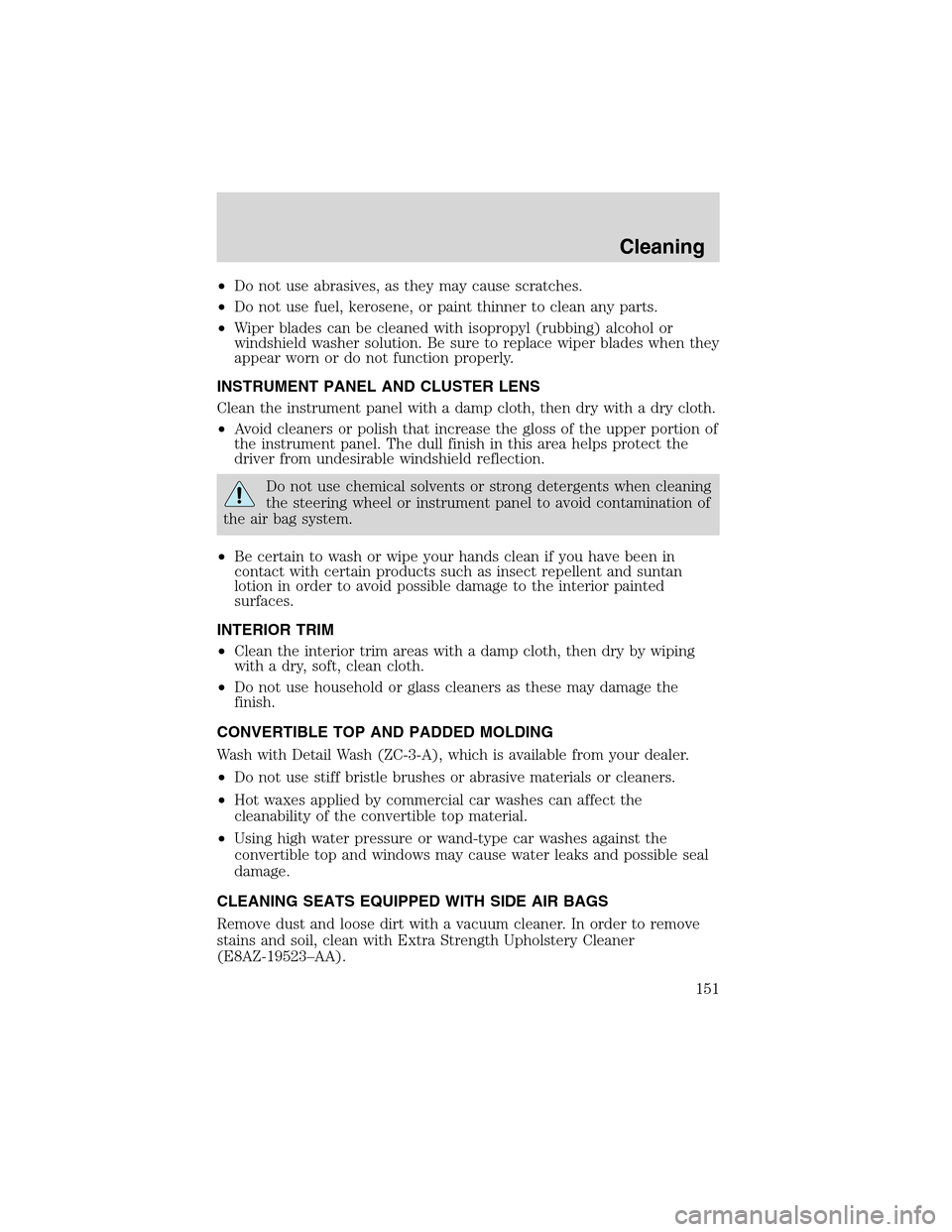
•Do not use abrasives, as they may cause scratches.
•Do not use fuel, kerosene, or paint thinner to clean any parts.
•Wiper blades can be cleaned with isopropyl (rubbing) alcohol or
windshield washer solution. Be sure to replace wiper blades when they
appear worn or do not function properly.
INSTRUMENT PANEL AND CLUSTER LENS
Clean the instrument panel with a damp cloth, then dry with a dry cloth.
•Avoid cleaners or polish that increase the gloss of the upper portion of
the instrument panel. The dull finish in this area helps protect the
driver from undesirable windshield reflection.
Do not use chemical solvents or strong detergents when cleaning
the steering wheel or instrument panel to avoid contamination of
the air bag system.
•Be certain to wash or wipe your hands clean if you have been in
contact with certain products such as insect repellent and suntan
lotion in order to avoid possible damage to the interior painted
surfaces.
INTERIOR TRIM
•Clean the interior trim areas with a damp cloth, then dry by wiping
with a dry, soft, clean cloth.
•Do not use household or glass cleaners as these may damage the
finish.
CONVERTIBLE TOP AND PADDED MOLDING
Wash with Detail Wash (ZC-3-A), which is available from your dealer.
•Do not use stiff bristle brushes or abrasive materials or cleaners.
•Hot waxes applied by commercial car washes can affect the
cleanability of the convertible top material.
•Using high water pressure or wand-type car washes against the
convertible top and windows may cause water leaks and possible seal
damage.
CLEANING SEATS EQUIPPED WITH SIDE AIR BAGS
Remove dust and loose dirt with a vacuum cleaner. In order to remove
stains and soil, clean with Extra Strength Upholstery Cleaner
(E8AZ-19523–AA).
Cleaning
151
Page 174 of 200
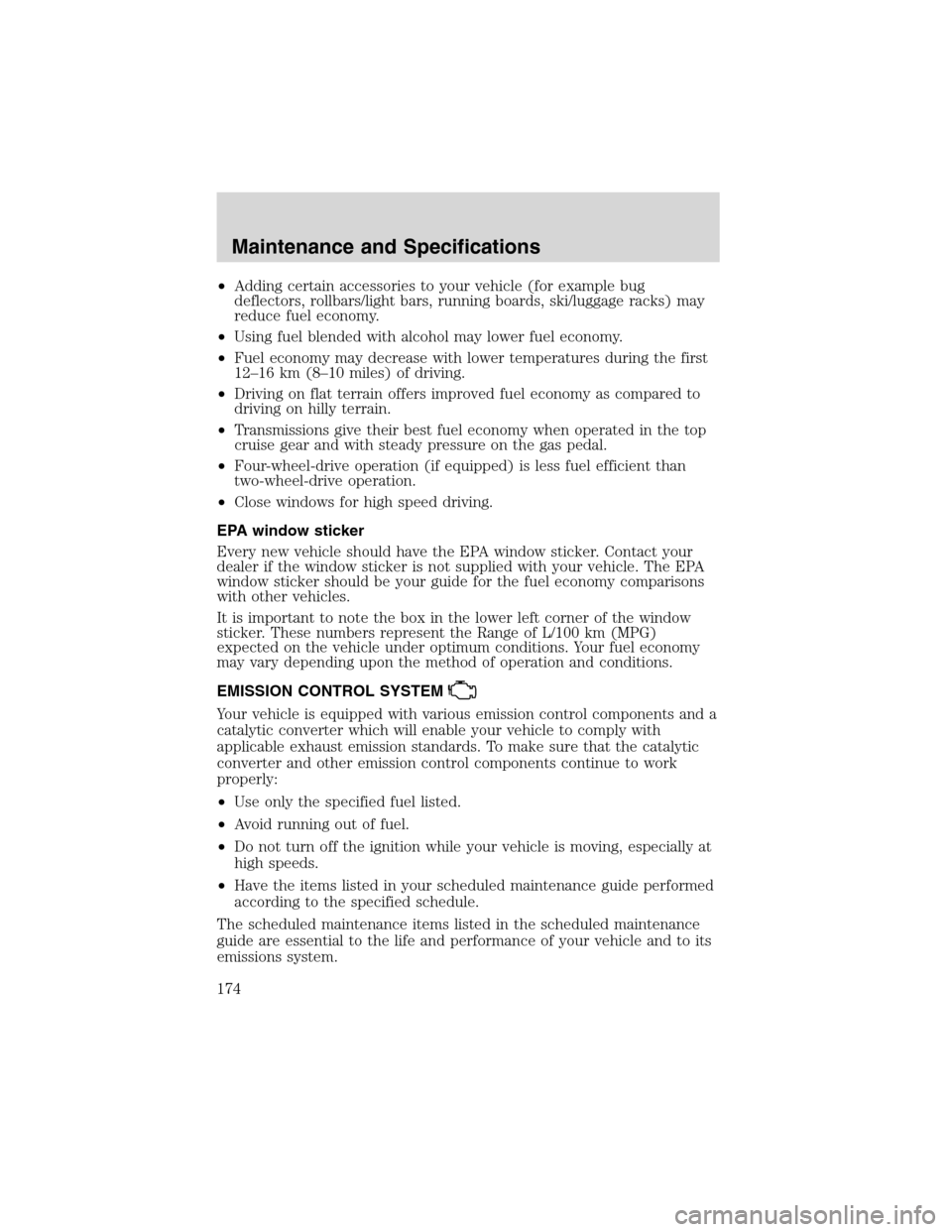
•Adding certain accessories to your vehicle (for example bug
deflectors, rollbars/light bars, running boards, ski/luggage racks) may
reduce fuel economy.
•Using fuel blended with alcohol may lower fuel economy.
•Fuel economy may decrease with lower temperatures during the first
12–16 km (8–10 miles) of driving.
•Driving on flat terrain offers improved fuel economy as compared to
driving on hilly terrain.
•Transmissions give their best fuel economy when operated in the top
cruise gear and with steady pressure on the gas pedal.
•Four-wheel-drive operation (if equipped) is less fuel efficient than
two-wheel-drive operation.
•Close windows for high speed driving.
EPA window sticker
Every new vehicle should have the EPA window sticker. Contact your
dealer if the window sticker is not supplied with your vehicle. The EPA
window sticker should be your guide for the fuel economy comparisons
with other vehicles.
It is important to note the box in the lower left corner of the window
sticker. These numbers represent the Range of L/100 km (MPG)
expected on the vehicle under optimum conditions. Your fuel economy
may vary depending upon the method of operation and conditions.
EMISSION CONTROL SYSTEM
Your vehicle is equipped with various emission control components and a
catalytic converter which will enable your vehicle to comply with
applicable exhaust emission standards. To make sure that the catalytic
converter and other emission control components continue to work
properly:
•Use only the specified fuel listed.
•Avoid running out of fuel.
•Do not turn off the ignition while your vehicle is moving, especially at
high speeds.
•Have the items listed in your scheduled maintenance guide performed
according to the specified schedule.
The scheduled maintenance items listed in the scheduled maintenance
guide are essential to the life and performance of your vehicle and to its
emissions system.
Maintenance and Specifications
174
Page 192 of 200
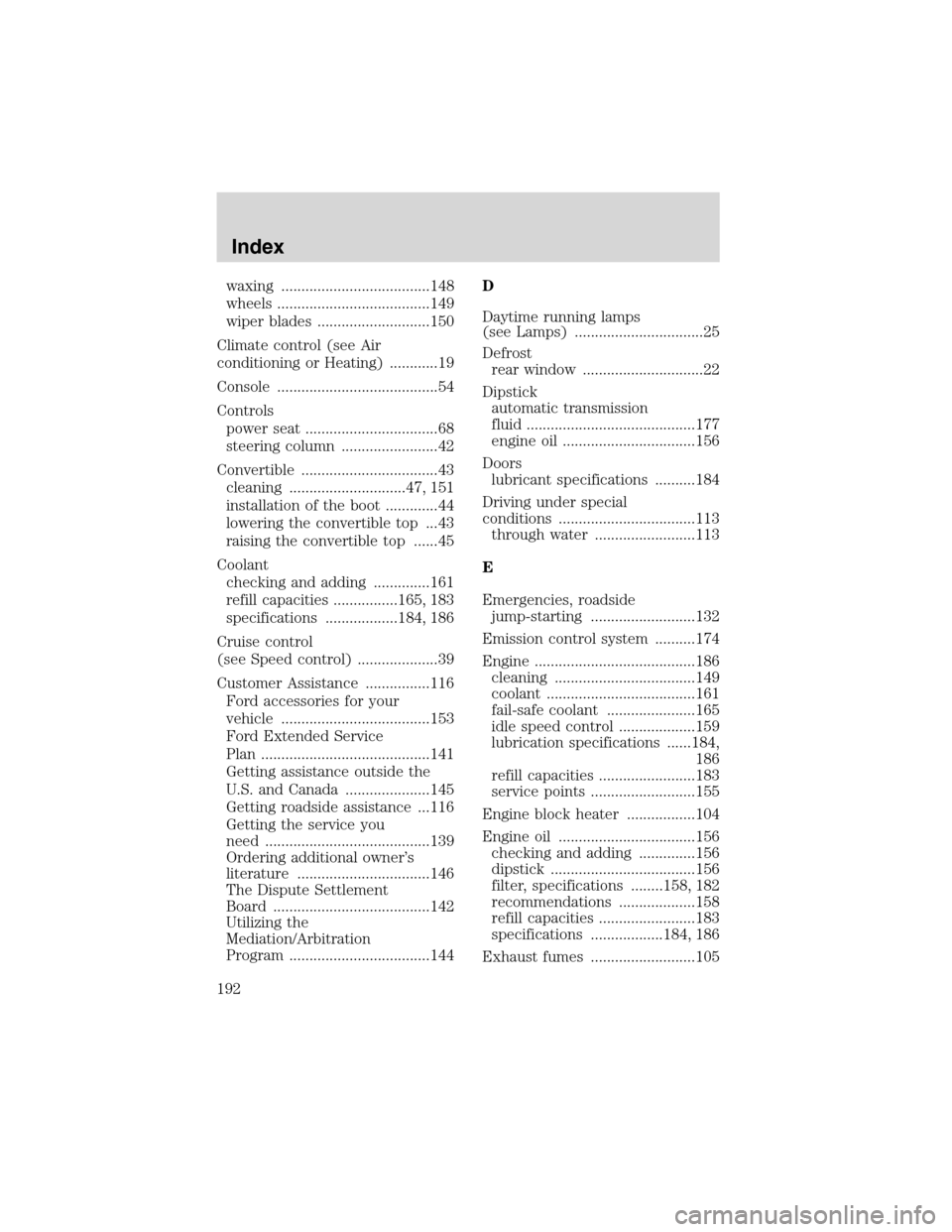
waxing.....................................148
wheels ......................................149
wiper blades ............................150
Climate control (see Air
conditioning or Heating) ............19
Console ........................................54
Controls
power seat .................................68
steering column ........................42
Convertible ..................................43
cleaning .............................47, 151
installation of the boot .............44
lowering the convertible top ...43
raising the convertible top ......45
Coolant
checking and adding ..............161
refill capacities ................165, 183
specifications ..................184, 186
Cruise control
(see Speed control) ....................39
Customer Assistance ................116
Ford accessories for your
vehicle .....................................153
Ford Extended Service
Plan ..........................................141
Getting assistance outside the
U.S. and Canada .....................145
Getting roadside assistance ...116
Getting the service you
need .........................................139
Ordering additional owner’s
literature .................................146
The Dispute Settlement
Board .......................................142
Utilizing the
Mediation/Arbitration
Program ...................................144D
Daytime running lamps
(see Lamps) ................................25
Defrost
rear window ..............................22
Dipstick
automatic transmission
fluid ..........................................177
engine oil .................................156
Doors
lubricant specifications ..........184
Driving under special
conditions ..................................113
through water .........................113
E
Emergencies, roadside
jump-starting ..........................132
Emission control system ..........174
Engine ........................................186
cleaning ...................................149
coolant .....................................161
fail-safe coolant ......................165
idle speed control ...................159
lubrication specifications ......184,
186
refill capacities ........................183
service points ..........................155
Engine block heater .................104
Engine oil ..................................156
checking and adding ..............156
dipstick ....................................156
filter, specifications ........158, 182
recommendations ...................158
refill capacities ........................183
specifications ..................184, 186
Exhaust fumes ..........................105
Index
192
Page 194 of 200
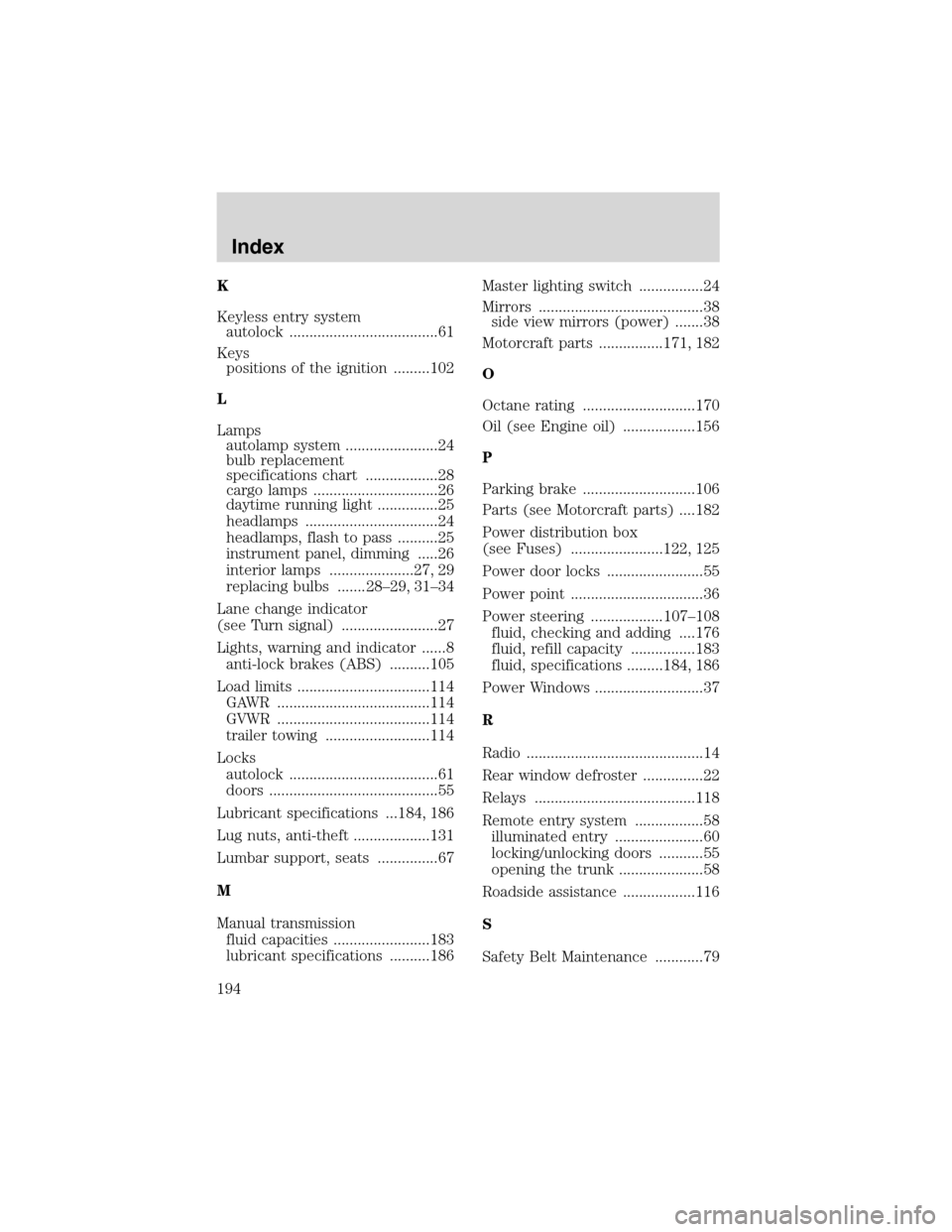
K
Keylessentrysystem
autolock.....................................61
Keys
positions of the ignition .........102
L
Lamps
autolamp system .......................24
bulb replacement
specifications chart ..................28
cargo lamps ...............................26
daytime running light ...............25
headlamps .................................24
headlamps, flash to pass ..........25
instrument panel, dimming .....26
interior lamps .....................27, 29
replacing bulbs ....... 28–29, 31–34
Lane change indicator
(see Turn signal) ........................27
Lights, warning and indicator ......8
anti-lock brakes (ABS) ..........105
Load limits .................................114
GAWR ......................................114
GVWR ......................................114
trailer towing ..........................114
Locks
autolock .....................................61
doors ..........................................55
Lubricant specifications ...184, 186
Lug nuts, anti-theft ...................131
Lumbar support, seats ...............67
M
Manual transmission
fluid capacities ........................183
lubricant specifications ..........186Master lighting switch ................24
Mirrors .........................................38
side view mirrors (power) .......38
Motorcraft parts ................171, 182
O
Octane rating ............................170
Oil (see Engine oil) ..................156
P
Parking brake ............................106
Parts (see Motorcraft parts) ....182
Power distribution box
(see Fuses) .......................122, 125
Power door locks ........................55
Power point .................................36
Power steering ..................107–108
fluid, checking and adding ....176
fluid, refill capacity ................183
fluid, specifications .........184, 186
Power Windows ...........................37
R
Radio ............................................14
Rear window defroster ...............22
Relays ........................................118
Remote entry system .................58
illuminated entry ......................60
locking/unlocking doors ...........55
opening the trunk .....................58
Roadside assistance ..................116
S
Safety Belt Maintenance ............79
Index
194